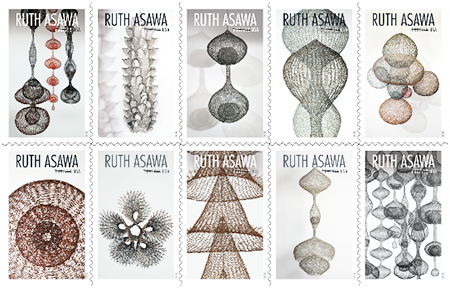Copper Sculptor Ruth Asawa Celebrated by USPS With Line of Commemorative Stamps
The U.S. Postal Service recently announced a new line of Forever Stamps, featuring the work of world-renown copper artist Ruth Asawa, best known for her intricate abstract wire sculptures.
 Artist Ruth Asawa's Commerative USPS Forever Stamps.
Artist Ruth Asawa's Commerative USPS Forever Stamps. Photograph courtesy of USPS.
Inspired by nature, Asawa is best known for transforming industrial material into transparent and seemingly weightless works of art that challenged traditional definitions of sculpture.
The new collection features 20 stamps, two each of 10 designs, featuring photographs by Laurence Cuneo and Dan Bradica for David Zwirner. The selvage features a photograph of Asawa taken by Nat Farbman in 1954 for Lifemagazine. Ethel Kessler served as art director and designer for this issuance.
“The Postal Service takes tremendous pride in its stamp program, which celebrates the very best of American life, history and culture,” said dedicating official Sharon D. Owens, Vice President, Pricing and Costing, U.S. Postal Service at the debut event. “Today we’re dedicating a new stamp set that honors the groundbreaking and iconic works of Ruth Asawa — one of the greatest American artists of the past century.”
 Ruth Asawa (1926-2013), Untitled (S.401, Hanging
Ruth Asawa (1926-2013), Untitled (S.401, Hanging
Seven-Lobed, Continuous Interlocking Form, with Spheres
within Two Lobes), circa 1953-1954. Hanging sculpture,
enamelled copper and brass wire. 78 x 15 x 15 in (198.1 x
38.1 x 38.1 cm). Sold for $5,382,500 in ONE: A Global
Sale of the 20th Century on 10 July 2020 at Christie’s in
New York.© The Estate of Ruth Asawa / Artists Rights Society
(ARS), New York.
Owens was joined for the ceremony by Paul Lanier, son of Ruth Asawa; George Takei, chair emeritus of the board of trustees and founding member, Japanese American National Museum; and Jonathan Laib, director, David Zwirner. The virtual stamp event was also showcased on the Postal Service’s Facebook and Twitter pages.
Asawa began making her wire sculptures in 1947 when she was just a student at legendary Black Mountain College. Working with whatever wire was available, she made long series of e-shaped loops, similar to knitting loops through a slow and painstaking process. Asawa soon discovered that in addition to single-layered sculptures, she could also create continuous or intersecting surfaces.
Sensual and organic, these multilayered yet still transparent works created a dynamic interplay between interior and exterior surfaces. Inspired by plants, snail shells, spiderwebs, insect wings and water droplets, Asawa’s sculptures, when shown together, can evoke an undersea domain, a magical upside-down world or an environment all their own.
In addition to her wire sculptures, Asawa is also acclaimed for her large public projects, which include several fountains in San Francisco; the Japanese American Internment Memorial in San Jose, CA; and San Francisco State University’s Garden of Remembrance, which commemorates Japanese Americans interned during World War II. Last July, one of Asawa’s sculptures sold for more than $5.3 million at Christie’s in New York.Resources:
Also in this Issue:
- Copper Artist Ronald Stauffer Honored by Amazon
- Robin Tost: Giving Form to the Discarded
- Copper Sculptor Ruth Asawa Celebrated by USPS With Line of Commemorative Stamps
- Copper’s Place in Pennsylvania German Metalwork
- Grounds for Sculpture Remains Open for Winter Viewers
